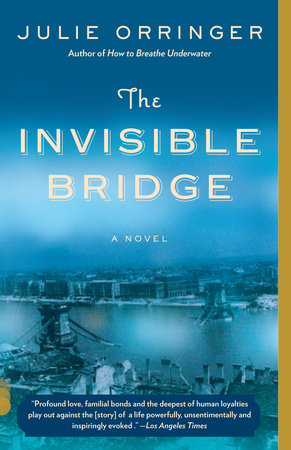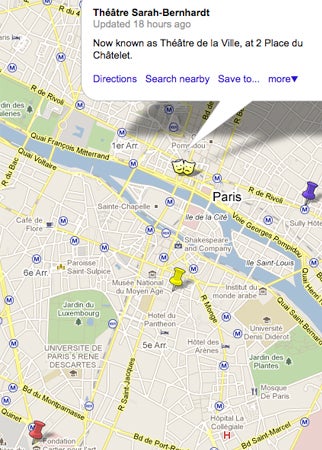Reading Group Center
- Home •
- Books by Category •
- Imprints •
- News •
- Videos •
- Media Center •
- Reading Group Center
Armchair Adventurer: Paris, Budapest, and The Invisible Bridge
Welcome to Armchair Adventurer, a new Reading Group Center feature that explores the exciting settings of your favorite reading group books and the homelands of beloved international authors! Travel without ever leaving the comfort of your home, as we provide interesting and helpful resources that will provide insight for your book club’s discussions. From travel tips to walking tours, author backgrounds to historical contexts, let the Armchair Adventurer be your guide.
Julie Orringer’s The Invisible Bridge is a tale of two cities. The first half is devoted to pre-World War II Paris, and the second, to wartime Budapest. Orringer writes with affection for both cities, giving the reader a window into two venerable European capitols, each destinations in their own right. To give you a literary lay of the land, we’ve put together book-centric Google Maps for each city, and detailed a few of the book’s key landmarks. Please note that although we have avoided major plot spoilers, some readers may wish to save the below article until after they have read the book.
Paris in The Invisible Bridge
For a unique literary tour of Paris, click the screenshot to visit our “Invisible Bridge in Paris” Google Map! Below, a few in-depth descriptions of Andras’ Parisian haunts.
L’École Spéciale d’Architecture
The L’École Spéciale d’Architecture, where Andras takes up his studies, is an actual architecture school that still exists in Paris today (French speakers can click here to read a full history of the school). L’École Spéciale was founded in 1865 (72 years before Andras’ enrollment) as an alternative to the École des Beaux-Arts. Teachers there included Auguste Perret and Pierre Vago, both of whom appear in fictionalized form in The Invisible Bridge. Vago is perhaps best known for designing the Basilica of St Pius X at Lourdes, while Perret is known for his work on Théâtre des Champs-Élysées and his reconstruction of La Havre after World War II.
Théâtre Sarah-Bernhardt
The Théâtre Sarah-Bernhardt, where Andras finds employment, has undergone several changes in name and design since its first opening. The building was designed by Gabriel Davioud in 1860. In 1898, Sarah Bernhardt herself ran the theater, and the name was changed in her honor. During the German occupation, the theater was renamed Théâtre de la Cite; after the war it was renamed again, Théâtre des Nations. The theater shut down in the 1960s for renovations, reopening in 1968 with Davioud’s original façade carefully preserved, and a new name: Theatre de la Ville. Today, the theater hosts world-class theater, dance, and music events.
Bois de Vincennes
Bois de Vincennes is a large public park in eastern Paris (“bois” is French for “woods”) that was once a royal hunting ground. Inside the park, visitors will find lakes with islands, a working organic farm, a race track, a zoo (and an aquarium!), a Buddhist temple, a botanic garden, bike and bridle paths, and a theater. Bois de Vincennes is also home to the Château de Vincennes, the only fortified castle in Paris. Originally a hunting lodge (and later, a state penitentary), it is now a national monument, and open to visitors.
Interested in Visting Paris?
Click here for Fodor’s recommendations of the city’s top attractions. Fans of The Invisible Bridge might pay special attention to this walking tour of the Left Bank, where much of the book’s action takes place.
If a trip to Paris is not in your near future—or even if it is—you can take a journey into Andras’ Paris by watching the video below. This archival footage of 1930s-era Paris shows the city as it would have looked to him: the landmarks, the open air markets, and the busy city streets.
Budapest in The Invisible Bridge
Click on the screenshot to visit our “Invisible Bridge in Budapest” Google Map! Below, some more background on the city and its landmarks.
Budapest’s Geography and Bridges
Though Andras and his family are from Konyár, a village in the eastern part of Hungary, Orringer begins her story in Budapest, where Andras and his older brother Tibor move as young adults. Budapest is Hungary’s capitol, and its largest city. The Danube River divides the city into two halves, Buda in the west and Pest in the east, which were united in 1873 to form the nation’s capitol. Budapest has eight bridges connecting its two halves, the most famous of which is The Chain Bridge, the first permanent stone bridge to connect Buda and Pest. The bridge was destroyed during the 1945 Siege of Budapest, and rebuilt in 1949. The bridge has a pedestrian path, offering unique views of the Parliament (when approaching Pest) and Castle Hill (when approaching Buda).
Hungarian State Opera House
In the book’s opening chapter, the Levi brothers visit The Royal Hungarian Opera House to see a performance of Tosca. The opera house was designed by Miklós Ybl and opened to the public in 1884. Click here for a virtual tour of the opera house, including a 360-degree view of the foyer that Andras is studying so carefully when he first meets Elza Hász. After shutting down for renovation in the 1980s, the opera house re-opened on its centennial in 1984 and currently boasts a busy schedule of opera, ballet, and concerts.
Dohány Street Synagogue
The largest synagogue in Europe (and the second largest in the world), The Dohány Street Synagogue opened in 1859. It is located in Budapest’s old Jewish quarter and was the center of the stone-walled Jewish ghetto where Jews were forced to live during World War II. In addition to being an active place of workship, the synogogue now houses the Hungarian Jewish Museum, the Raoul Wallenberg Holocaust Memorial Park, and a Jewish cemetary, where over 2,000 Jews were buried following the harsh 1944-45 winter.
Planning a Trip to Budapest?
Check out the city’s official tourism site for sightseeing ideas and lists of touring companies that will take you around the city by foot, bike, or boat. You may also wish to visit the Budapest Holocaust Memorial Center; click here for the official website.
More About the Book
Click to read an excerpt from Julie Orringer’s The Invisible Bridge,, download our free reading group guide, and schedule a phone chat with the author.




